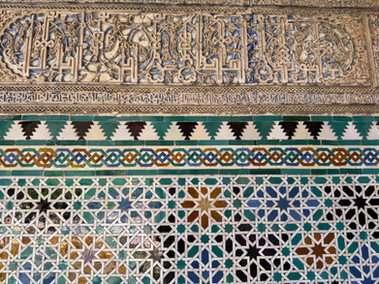Andalusia: Where Cultures Intertwine
- Zaina Kourki
- 4 minutes ago
- 4 min read
This summer, when I traveled through southern Spain—wandering the courtyards of Seville’s Alcázar, stepping into the echoing arches of the Mosque–Cathedral of Córdoba, and exploring the vibrant cultural landscape of Málaga—I wasn’t searching for postcard moments or must-see lists. I was drawn instead to the layers of identity that Andalusia carries, a region where histories don’t simply follow one another; they overlap, blend, and influence the present.
Andalusia is one of the rare places in Europe where Moorish, Mediterranean, and diverse religious influences coexist visibly. The region’s identity was profoundly shaped during the Umayyad dynasty, when Córdoba became a center of learning, architecture, and cultural exchange that resonated across the Arab world and Europe. The result is a cultural fabric that feels both familiar and surprising, especially for someone coming from the Middle East, where many of these artistic and architectural languages originated.
Echoes of Damascus in Seville
In the Alcázar of Seville, the Mudéjar architecture reveals a dialogue between cultures rather than a dominance of one over another. The delicate stucco carvings, geometric patterns, and tranquil inner courtyards reminded me instantly of the architecture I grew up seeing in Syria—spaces that are designed not only for beauty but for contemplation. The emphasis on symmetry, calligraphy, light, and water reflects the same philosophies behind the great houses and palaces of Damascus and Aleppo.
But Seville’s connection to the Middle East extends far beyond the walls of the Alcázar. Wandering through the narrow streets of Santa Cruz, I felt the same intimacy as walking in the old neighborhoods of my hometown. The maze-like alleys that suddenly open into small plazas, the shaded passageways designed to stay cool in the summer heat, the climbing vines, the whitewashed walls, the bursts of bougainvillea—these elements feel like distant cousins of Old Damascus, where architecture is shaped not only by aesthetics but by climate, community, and memory. The city also carries the imprint of Moorish influence, visible in its fortified walls, decorative tilework, and the enduring spirit of Al-Andalus that bridged North Africa and Iberia.
Córdoba: A Sacred Space Shared
Standing beneath the endless red-and-white arches of the Mezquita of Córdoba, it becomes impossible to ignore how cultures imprint themselves on one another. Originally a mosque, later transformed into a cathedral, the building carries both identities without collapsing into a single narrative. The geometry and quiet spirituality of Islamic architecture remain fully intact, while the later Christian nave rises dramatically at the center. The coexistence is striking—not entirely harmonious, not entirely conflicted—yet undeniably powerful.
Walking through the city of Córdoba reveals layers of identity woven into its urban form. With its narrow labyrinth of alleys, whitewashed walls, and hidden courtyards, it mirrors the urban logic of many old Middle Eastern cities, including Damascus. Córdoba’s courtyard culture, celebrated every May in the Festival de los Patios, also carries a familiar Middle Eastern instinct: life organized around an inward-facing garden. The courtyards overflow with flowers, ceramics, and water features—symbols of beauty, hospitality, and serenity. Like the Syrian courtyard home, the Andalusian patio is both practical and poetic, a space where architecture protects the family’s private world while honoring the tradition of gathering, storytelling, and celebration.
Málaga: Where Art and Identity Expand
If Seville and Córdoba express their histories through stone, Málaga expresses its identity through creativity. What struck me most was the city’s cultural pulse—alive, contemporary, and layered with influences that stretch far beyond Andalusia. As the birthplace of Pablo Picasso, Málaga carries an artistic energy that feels both deeply rooted and forward-looking. His legacy is felt not only in the Picasso Museum or his childhood home on Plaza de la Merced, but in the way the entire city embraces experimentation and dialogue across styles and eras.
Walking through Málaga, you move from the contemporary collections of the Centre Pompidou to the Andalusian focus of the Carmen Thyssen Museum, from interactive musical traditions at MIMMA to the modern voices at the Contemporary Art Centre (CAC). Even the ancient Roman Theatre, resting quietly beneath the Alcazaba, adds another cultural layer, reminding visitors of the civilizations that shaped this coastline long before Al-Andalus. Málaga doesn’t just preserve culture; it lives it—inviting you into a vibrant landscape where history, art, and global influences continually meet and reshape one another.
Where Cultures Connect
Travelling through Seville, Córdoba, and Málaga made me think about how cultures survive not only through monuments, but through the way people carry memories, influences, and ideas from one place to another. Andalusia is full of reminders that civilizations are constantly in conversation—sometimes separated by centuries, sometimes by geography, yet always connected by creativity and exchange.
Cultural connection is not something we create; it already exists. What matters is whether we choose to notice it. The echoes between the Middle East and southern Spain felt like an invitation to keep exploring the stories that live between cultures and the spaces where they overlap. Andalusia stands as a symbol of what becomes possible when cultures meet—not with fear, but with curiosity.









































